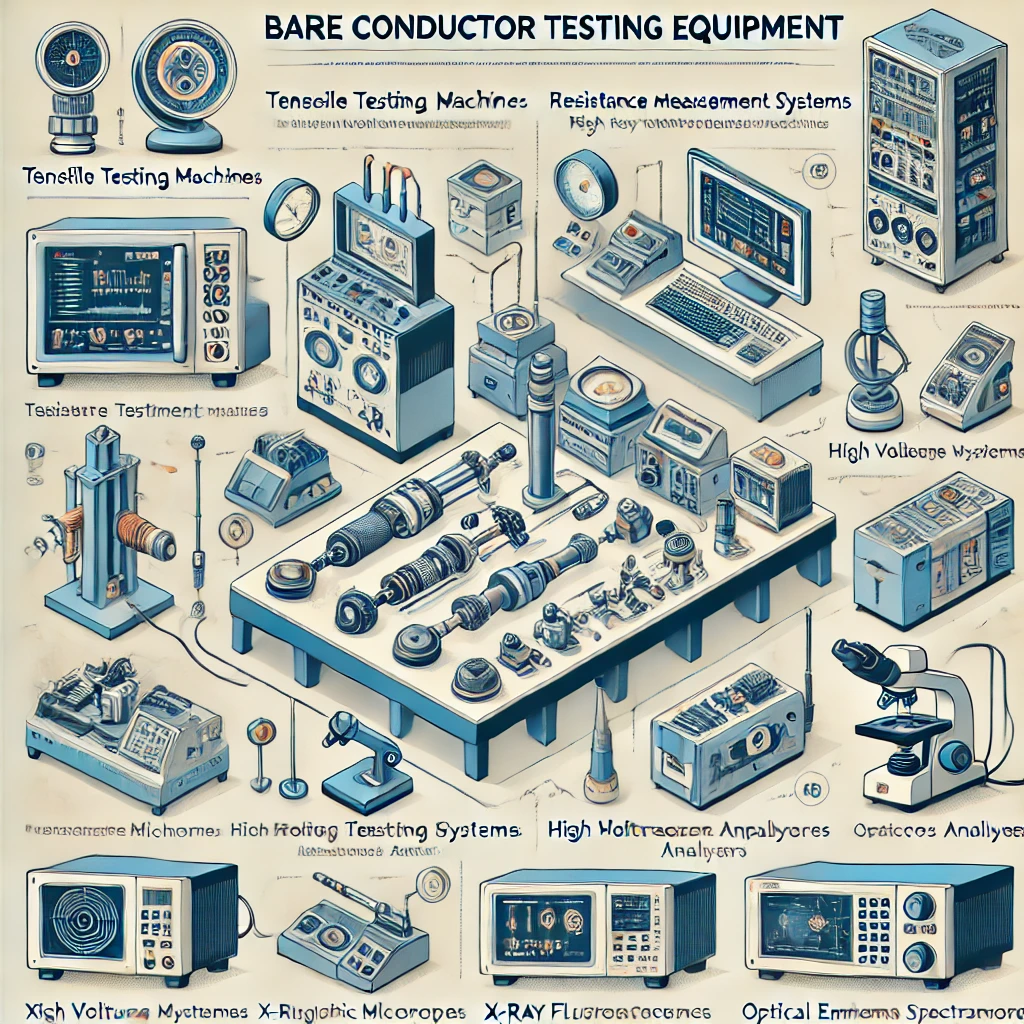
Testing equipment is crucial in the production of bare conductors to ensure they meet industry standards for quality, performance, and safety. This document provides an overview of the essential testing equipment used in the manufacturing of bare conductors, including specific models, technical details, and indicative pricing.
Key Testing Equipment for Bare Conductors
1. Tensile Testing Machine
Tensile testing machines are used to measure the tensile strength and elongation of conductors, which are critical parameters for assessing mechanical performance.
- Model: Instron 5980 Series
- Specifications:
- Load Capacity: Up to 250 kN
- Crosshead Speed: 0.001 to 1000 mm/min
- Accuracy: ±0.5% of reading down to 1/1000th of load cell capacity
- Features: High precision, user-friendly software, versatile fixtures.
- Price: Approximately $50,000 – $100,000
- Specifications:
2. Resistance Measurement System
Resistance measurement systems are used to determine the electrical resistance of conductors, ensuring they meet the required conductivity standards.
- Model: Megger DLRO10HD
- Specifications:
- Measurement Range: 0.1 µΩ to 2000 Ω
- Accuracy: ±0.2% ±0.2 µΩ
- Display: LCD with backlight
- Features: Portable, robust, and high accuracy.
- Price: Approximately $10,000 – $20,000
- Specifications:
3. High Voltage Testing Machine
High voltage testing machines are essential for testing the insulation and dielectric strength of conductors under high voltage conditions.
- Model: Haefely Hipotronics 700 Series
- Specifications:
- Voltage Range: Up to 300 kV
- Current Range: Up to 10 A
- Frequency: 50/60 Hz
- Features: Precision control, safety features, and robust construction.
- Price: Approximately $50,000 – $150,000
- Specifications:
4. Metallographic Microscope
Metallographic microscopes are used for the microscopic examination of conductor materials to check for defects, grain structure, and surface quality.
- Model: Olympus GX53
- Specifications:
- Magnification: Up to 1000x
- Illumination: LED with polarization capability
- Camera: Optional digital camera attachment
- Features: High resolution, advanced imaging software, and ergonomic design.
- Price: Approximately $30,000 – $50,000
- Specifications:
5. X-ray Fluorescence (XRF) Analyzer
XRF analyzers are used for the non-destructive analysis of the elemental composition of conductor materials, ensuring they meet specified alloy compositions.
- Model: Bruker S1 TITAN
- Specifications:
- Detection Range: Na to U
- Resolution: <140 eV
- Analysis Time: 2-60 seconds
- Features: Portable, fast analysis, and high accuracy.
- Price: Approximately $40,000 – $70,000
- Specifications:
6. Optical Emission Spectrometer (OES)
OES machines are used to analyze the chemical composition of metals by examining the emitted light from a sample when it is excited by a spark.
- Model: Spectro Arcos
- Specifications:
- Wavelength Range: 130-800 nm
- Resolution: High spectral resolution
- Detection Limit: ppm level
- Features: High precision, fast analysis, and robust design.
- Price: Approximately $100,000 – $200,000
- Specifications:
Conclusion
The production of bare conductors requires precise and reliable testing equipment to ensure that the final products meet stringent industry standards. From tensile testing machines to advanced spectrometers, each piece of equipment plays a crucial role in verifying the mechanical, electrical, and chemical properties of conductors. The models and specifications provided here represent some of the state-of-the-art options available in the market, reflecting the latest technological advancements in the industry.
For more detailed information and the latest pricing, it is recommended to consult directly with equipment manufacturers and suppliers. Some prominent suppliers in this field include Instron, Megger, Haefely Hipotronics, Olympus, Bruker, and Spectro. These companies offer comprehensive solutions and support to meet the specific needs of bare conductor testing.
References
- Instron: Instron Testing Machines
- Megger: Megger Electrical Test Equipment
- Haefely Hipotronics: Haefely High Voltage Test Systems
- Olympus: Olympus Industrial Microscopes
- Bruker: Bruker XRF Analyzers
- Spectro: Spectro Analytical Instruments
